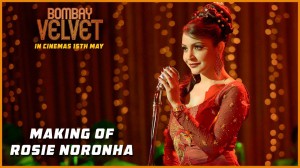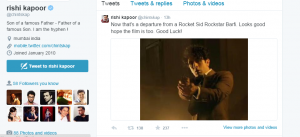Hindi Cinema: Coming Soon To A Tweet Near You
Post by Sripana Ray, The Telegraph, Calcutta
This post continues the ongoing “From Nottingham and Beyond” series, with contributions from faculty and alumni of the University of Nottingham’s Department of Culture, Film and Media. This week’s contributor, Sripana Ray, completed her PhD in the department in 2014.
 As part of my current job, I recently did an ethnographic study, looking at how young, urban, middle-class Indians—the target audience group for the entertainment portal The Telegraph is about to launch—engage with online spaces. The two key conclusions that we drew from the several interviews we conducted in cities such as Delhi, Bombay and Bangalore were that India’s young, urban media consumers only look for instant information and that they use that information to realize their aspirations for a better lifestyle. As several of the respondents stated, that information—whether on politics, sports or films—is chiefly consumed on laptops, tablets and smartphones. There is no denying that with the proliferation of media technologies, this is the age of instant gratification–instant download, instant messaging, an Instagrammed world that needs to be made instagood.
As part of my current job, I recently did an ethnographic study, looking at how young, urban, middle-class Indians—the target audience group for the entertainment portal The Telegraph is about to launch—engage with online spaces. The two key conclusions that we drew from the several interviews we conducted in cities such as Delhi, Bombay and Bangalore were that India’s young, urban media consumers only look for instant information and that they use that information to realize their aspirations for a better lifestyle. As several of the respondents stated, that information—whether on politics, sports or films—is chiefly consumed on laptops, tablets and smartphones. There is no denying that with the proliferation of media technologies, this is the age of instant gratification–instant download, instant messaging, an Instagrammed world that needs to be made instagood.
The producers of contemporary Hindi commercial cinema have accommodated this generation’s immediate needs by reaching out through various online channels, especially social networks. Online discourses, particularly the ones conducted by film stars, give consumers of Hindi films a sense of belonging to the carefully constructed “real world” of these stars, feeding and fostering consumers’ aspirations.
Promotions of Hindi films routinely occur on Twitter, Facebook, Instagram and other social platforms. Strangely enough, in the promotion exercise, there is a sense of fragmented gratification. The process has several stages, starting with the unveiling of the first look, usually a poster, followed by the release of the soundtrack and trailers. For some films, as was the case with Piku (Shootjit Sircar, 2015), a trailer is produced for the trailer—both of which were released on social media first. Thus, the Hindi commercial film becomes, to modify Tom Gunning’s term slightly, a cinema of staggered attractions. (To view the clip below, click on the link to YouTube that appears after hitting the play button.)
The prefigurative route of assigning meaning to films, diverting from a strictly textual approach, has been a subject of growing interest among scholars. Martin Barker, in his article “News, Reviews, Clues, Interviews and Other Ancillary Materials,” notes that prefigurative materials or secondary texts, which include posters, trailers, reviews and interviews, “shape in advance the conditions under which interpretations of films are formed”[1]. These materials can give the audience a preview of what they would see and thus generate “expectations of pleasures,” or they might help form opinions about a particular film. These expectations and opinions, in turn, contribute to the construction of meaning of cinematic texts. The teaser of Piku, which shows the protagonists bantering about the quality of the upcoming trailer, gives viewers a hint about the characters’ personalities and the relationship they share, which is the premise of the film.
A central factor in the promotion of a Hindi commercial film is the star. In India, a film is labelled a blockbuster even “before the camera rolls,”[2] according to Andrew Willis. This means that the expectation of success determines the blockbuster status of a film. The elements that inspire such expectation include the director, the producer and the music composer, but most importantly the actors. The use of stars as a vehicle for promotion has evolved with time, primarily because of the public exposure stars get on television and online. The traditional methods of marketing a film, which included publishing and broadcasting sketchy information and gossip about film stars, have given way to a proper and more personal dialogue between actors and their audiences, abetted by the stars themselves. Through their Facebook and Twitter profiles, they talk about the films in which they star and give details about their personal relationships. In this sense, stars’ role in film prefiguration and promotion has now become much more direct. It is as if the stars have stepped out of the big screens to form an alternate narrative through an online discourse with fans that offers a glimpse of their “real” lives—the “reality” that these stars choose to reveal. It is a virtual transmission of projected reality.
Another strand of the promotional machinery becoming increasingly evident is the enmeshing of film stars’ virtual and real lives. Stars change their Twitter handles to the names of their characters in films–for example in Bombay Velvet (Anurag Kashyap, 2015) and Dil Dhadakne Do (Zoya Akhtar, 2015).
The Bombay Velvet trailer was released on Twitter, as was the soundtrack. As displayed in the image above, the film’s lead actress, Anushka Sharma, put the name of her character, Rosie Noronha, above her Twitter handle. The lead actor, Ranbir Kapoor, does not have a Twitter account. But his father, Rishi Kapoor (also an actor though not part of Bombay Velvet), ensured Ranbir Kapoor’s presence on the social network by continuously tweeting about him.
For viewers, the public preview of stars’ private lives stimulates what Barker calls “expectations of pleasures.” However, the process of generating these pleasures is almost exclusively geared towards English-speaking audiences in urban India, especially with the Internet’s rising importance in this process. While the Internet can increase direct, close contact with the audiences, the interaction is meant for a particular section of the audience. Blogs, social networking and online gaming are all designed for urban audiences with Internet access and a requisite knowledge of English, since the web discourse is conducted solely in English.
The increasing use of English in discourses surrounding Hindi commercial cinema appeals to its consumers’ global aspirations. English proficiency constitutes symbolic capital that aids in the exhibition of urban, middle-class status and in gaining access to it. The cultural currency of education in, or at least knowledge of, the English language has emerged as a primary tool shaping middle-class identities and aspirations. It is also one that the Hindi commercial film industry increasingly uses as an essential mode of signification as it actively tries to draw the urban middle classes.
According to Janet Staiger, “the reception of the film by the spectator is determined by the object, not the spectator.”[3] But how does the object function at a particular time and for particular people? Staiger argues that a specific object, in this case a film, cannot be consumed in the same way by a group of viewers since “individuals have multiple (albeit socially constructed) identities.” But these self-identities are shaped by certain historical and social agencies such as nationality, class and gender that homogenize certain facets of identity, which in turn creates a collective consciousness. In developing India, the way secondary texts affect processes of viewing and the collective consciousness of Hindi commercial-cinema audiences is being recast through a continuous modernization exercise.
[1] Martin Barker, “News, Reviews, Clues, Interviews and Other Ancillary Materials — A Critique and Research Proposal,” Scope, February 2004 (http://www.scope.nottingham.ac.uk/article.php?issue=feb2004&id=246).
[2] Andrew Willis, “Notes on the Hindi Blockbuster, 1975 to the Present,” in Movie Blockbusters, ed. Julian Stringer (New York: Routledge, 2003), 257.
[3] Janet Staiger, Interpreting Films: Studies in the Historical Reception of American Cinema (Princeton: Princeton University Press, 1992), 51.




